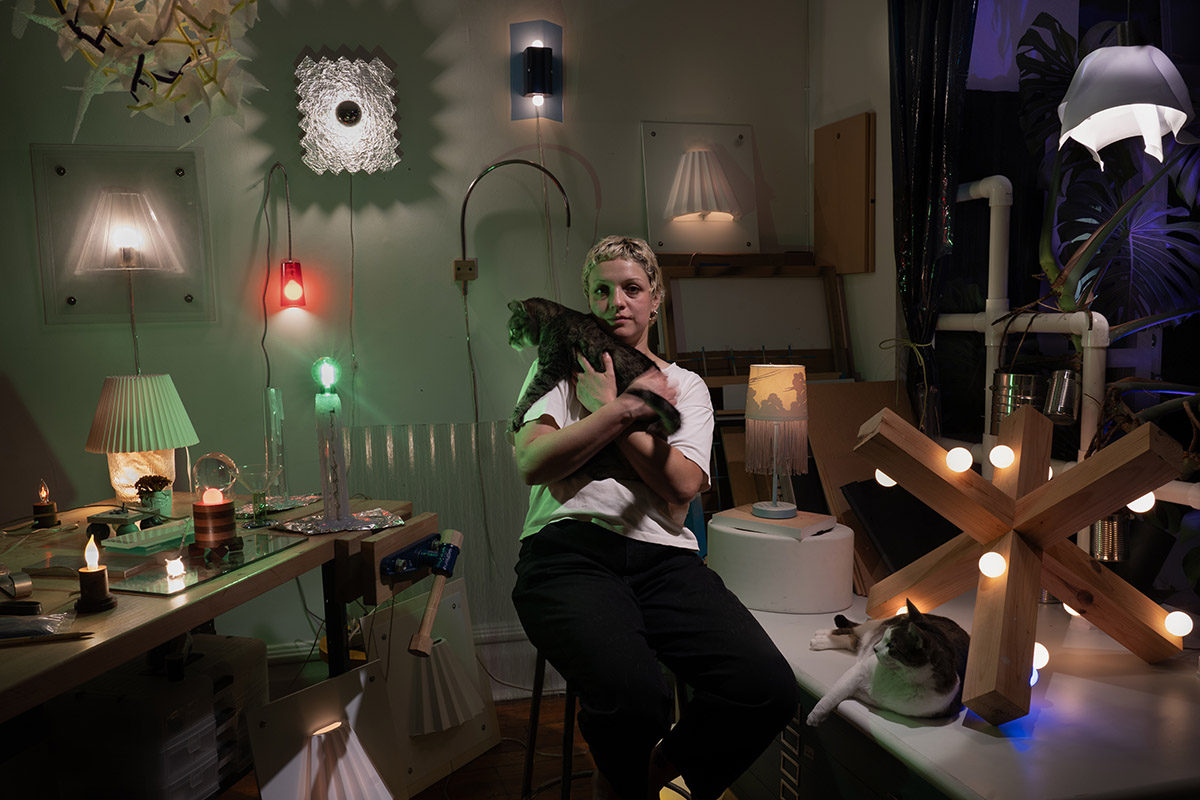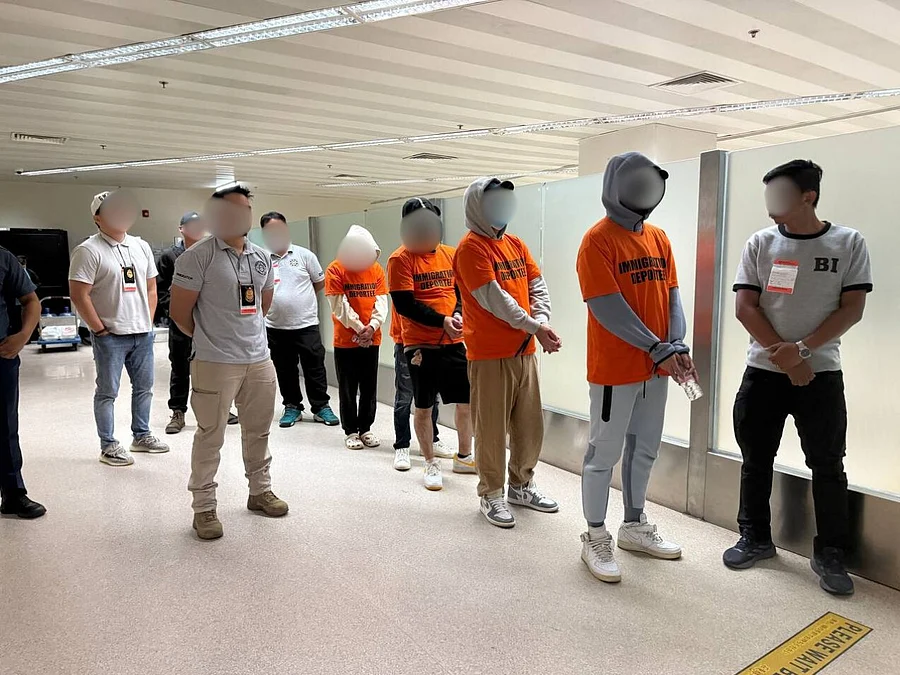By Kerry Cardoza
Copyright chicagoreader

Alessandra Norman is constantly rearranging the lighting in her East Pilsen apartment, which doubles as her studio. It makes sense—filled as it is with lamps of the artist’s making: Some are large, some small, some are hanging or mounted on the wall, others are more like floor sculptures. All are gorgeously designed and impeccably executed.
“A lot of living here has been learning how I live and think about objects,” she said.
The El Paso-born artist got into lampmaking by happenstance, though in many ways it dovetails perfectly with her more formal art practice, which is concerned with image proliferation and perception. Both allow Norman to ruminate on how information is conveyed and received visually (hence the desire to rearrange her lighting). She keeps a stash of light bulbs of various colors and wattages to put in the lamps, depending on the vibe.
Alessandra Normanalessandranorman.com/lamps
“It’s fun to me because you can also totally change the environment just based on the light and how it’s cast,” Norman said.
Norman started making lamps during the early days of COVID. She was unemployed, a year out of grad school, and sharing a studio with Lesley Jackson, who had a wealth of knowledge about woodworking (and a lot of free scrap material). “I had the ultimate amount of time to, like, dive into a new hobby, and I started just researching everything from scratch,” Norman said. A lot of these early lamps were conceived around whatever scrap wood was around: a Pac-Man-shaped block of wood painted yellow, with cheeselike holes, some of which sprout small clear or white bulbs; a series of small cylindrical lamps with multicolored flame-shaped bulbs; a plus-shaped wooden form that sits at a tilt, dotted with round bulbs.
This was technically not Norman’s first time making a lamp. While in grad school for print media at the School of the Art Institute of Chicago (SAIC), she wanted to fabricate a window with the blinds drawn, flashing blue and red lights behind them. So she took an art and technology class, which offered an introduction to electronics. She learned basic wiring; it was also the first time she set foot in the school’s woodshop. (Norman now works at SAIC’s Sullivan Fabrication Studio.)
“Before that, I was just drawing and doing printmaking, and I was, like, ‘I just need to make this, and I need to ask how.’ So that started everything. It started me working with found objects. It started me—I hate the word ‘woodworking,’ but, like, fabrication, and then it started with lights and with windows, and it’s just gone in those different directions.”
Norman’s paintings frequently reference windows. Drawing the Blinds, an enamel painting on medium-density fiberboard, looks like hanging window blinds with the shadows of tree branches showing through. Another enamel work, Forest Through the Trees, resembles window shades with an otherworldly green sky filtering through.
Compared to the labor and time required to make her paintings—which can take 60 to 70 hours to complete—the act of lampmaking has been freeing. “These [lamps] didn’t represent that type of investment risk,” Norman said. “You have nothing to lose. If you don’t like it, just make another one, and then you’ll do it better.”
Her lampmaking has always been more profitable than her artmaking. Most of her lamps weren’t on view in her studio because they’d been sold. Typically, as soon as she posts a new lamp on her Instagram, someone is interested in buying it. She’s also sold works at Tusk and at World of Variety pop-ups. She’d like to formalize these sales but finds there’s a lack of places in Chicago that sell artist-made, designed objects.
More recently, Norman has been experimenting with making lamps from both virgin material, like plastic, and waste material. A prototype she’s been working on features a 3D, traditional pleated lampshade popping out of a larger rectangular sheet of wall-mounted plastic. A bulb sits inside the “shade,” and is plugged into the wall.
A residency last fall at High Desert Test Sites in Joshua Tree inspired Norman to work more intentionally with waste material. Because the residency is located in the desert without many creature comforts—there are compostable toilets, outdoor showers—it got her thinking about how much trash we produce. “The world doesn’t need another vanity object. It feels really bad to be making new stuff, especially stuff that’s meant to be infinitely reproduced with new materials,” Norman said. “It feels less bad if I’m just taking stuff out of the trash stream. So I’ve started hoarding interesting materials.”It helps that Norman works at SAIC, where usable material is often discarded—not just offcuts of wood, but computer parts, television components, neon tubes. Though Norman wants to be careful with the way she talks about reusing material or found objects. “I never want to be seen as a recycled-materials artist. I feel like that’s doing a disservice to the potential of reuse,” she said. Even the term “reuse” puts the focus on the way a material is being used for a purpose other than what it was intended for. “It kind of devalues the material itself.”
These new directions have led to a realization that her art practice and her lampmaking practice come from the same interest in making images and understanding how meaning is constructed. Still, making lamps helps her feel grounded; it’s also more conducive to entering a creative flow state. “I just let my mind wander,” she said. “I don’t have that in the other parts of my practice, even drawing—it’s so freeing to work this way. It’s so freeing to just respond to material. It scratches all the ASMR itches.”
Norman works both at SAIC’s facilities and in her home studio—an open, organized space at the front of her apartment. When coming up with lamp ideas, she’ll often pull out materials that she’s been vibing on—strands of heat shrink, acrylic tubes, a purple dildo. Before my arrival, Norman contemplated taking all her lamps and setting them up in the studio but decided against it. “I want you to see as much as my lamps are a part of how I live and think about my space and myself in my space. All of this stuff allows me to just sort of sit and soup in my ideas when I’m washing dishes,” she said.
She’s working at appreciating objects in themselves, divorced from any preconceptions—it’s also what she hopes her work inspires in others. She pulls out a shiny metal object that looks vaguely electronic. “I mean, isn’t this so beautiful?” she marvelled. “It’s a heat sink for a [computer] server. And it looks beautiful.”



